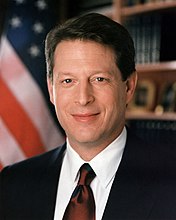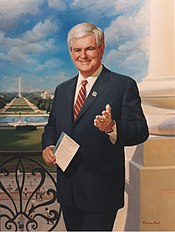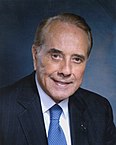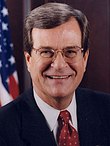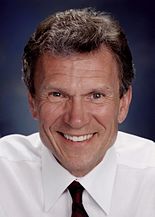| 104th United States Congress | |
|---|---|
103rd ← →
105th | |

United States Capitol (1996) | |
January 3, 1995 – January 3, 1997 | |
| Members | 100 senators 435 representatives 5 non-voting delegates |
| Senate majority | Republican |
| Senate President | Al Gore (D) |
| House majority | Republican |
| House Speaker | Newt Gingrich (R) |
| Sessions | |
| 1st: January 4, 1995 – January 3, 1996 2nd: January 3, 1996 – October 4, 1996 | |
The 104th United States Congress was a meeting of the legislative branch of the United States federal government, composed of the United States Senate and the United States House of Representatives. It met in Washington, D.C. from January 3, 1995, to January 3, 1997, during the third and fourth years of Bill Clinton's presidency. Apportionment of seats in the House of Representatives was based on the 1990 United States census.
Both chambers had Republican majorities for the first time since the 83rd Congress in 1953. Major events included passage of elements of the Contract with America and a budget impasse between Congress and the Clinton administration that resulted in the federal government shutdown of 1995 and 1996.
Major events
- January 3, 1995: Republicans gained control of both houses for the first time since 1955.
- January 31, 1995: President Clinton invoked emergency powers to extend a $20 billion loan to help Mexico avert financial collapse.
- April 19, 1995: Oklahoma City bombing
- August 30, 1995: NATO began Operation Deliberate Force against Serbs in Bosnia and Herzegovina
- November 14–19, 1995: U.S. government shutdown
- December 16, 1995 – January 6, 1996: U.S. government shutdown
- November 5, 1996: Re-election of President Bill Clinton; Democrats gained 8 seats in House; Republicans gained 2 seats in Senate.
Major legislation

- January 23, 1995: Congressional Accountability Act of 1995, Pub. L. 104–1 (text) (PDF)
- March 22, 1995: Unfunded Mandates Reform Act of 1995, Pub.L. 104-4
- April 10, 1995: Mexican Debt Disclosure Act of 1995, Pub. L. 104–6 (text) (PDF), 109 Stat. 73
- May 22, 1995: Paperwork Reduction Act of 1995, Pub.L. 104-13
- November 8, 1995: Jerusalem Embassy Act of 1995, Pub.L. 104-45
- November 28, 1995: National Highway System Designation Act of 1995, Pub. L. 104–59 (text) (PDF), 109 Stat. 568
- December 19, 1995: Lobbying Disclosure Act, Pub. L. 104–65 (text) (PDF), 109 Stat. 691, 2 U.S.C. ch. 26
- December 22, 1995: Private Securities Litigation Reform Act, Pub. L. 104–67 (text) (PDF), 109 Stat. 737
- December 28, 1995: Housing for Older Persons Act, Pub.L. 104-76
- December 29, 1995: ICC Termination Act of 1995, Pub.L. 104-88
- January 16, 1996: Federal Trademark Dilution Act, Pub.L. 104-98
- February 8, 1996: Telecommunications Act of 1996 (including the Communications Decency Act), Pub. L. 104–104 (text) (PDF), 110 Stat. 56, 47 U.S.C. § 609
- March 12, 1996: Cuban Liberty and Democratic Solidarity (Libertad) Act of 1996 (Helms-Burton Act), Pub. L. 104–114 (text) (PDF), 110 Stat. 785, 22 U.S.C. §§ 6021– 6091
- April 4, 1996: Federal Agriculture Improvement and Reform (FAIR) Act of 1996, Pub.L. 104-127
- April 9, 1996: Line Item Veto Act, Pub. L. 104–130 (text) (PDF), 110 Stat. 1200
- April 24, 1996: Antiterrorism and Effective Death Penalty Act, Pub. L. 104–132 (text) (PDF), 110 Stat. 1214
- May 13, 1996: Mercury-Containing and Rechargeable Battery Management Act, Pub.L. 104-142
- May 17, 1996: Megan's Law,
- July 30, 1996: Taxpayer Bill of Rights 2, Pub. L. 104–168 (text) (PDF), 110 Stat. 1452
- August 3, 1996: National Gambling Impact Study Commission Act, Pub. L. 104–169 (text) (PDF), 110 Stat. 1482
- August 3, 1996: Food Quality Protection Act of 1996, Pub. L. 104–170 (text) (PDF), 110 Stat. 1489, 7 U.S.C. § 136
- August 5, 1996: Iran and Libya Sanctions Act of 1996, Pub.L. 104-172
- August 20, 1996: Small Business Job Protection Act of 1996, Pub. L. 104–188 (text) (PDF), 110 Stat. 1755
- August 21, 1996: Health Insurance Portability and Accountability Act (HIPAA), Pub. L. 104–191 (text) (PDF), 110 Stat. 1936
- August 21, 1996: War Crimes Act of 1996, Pub.L. 104-192
- August 22, 1996: Personal Responsibility and Work Opportunity Act ( Welfare Reform Act), Pub. L. 104–193 (text) (PDF), 110 Stat. 2105
- September 21, 1996: Defense of Marriage Act, Pub. L. 104–199 (text) (PDF), 110 Stat. 2419
- September 26, 1996; Mental Health Parity Act, Pub.L. 104-204
- September 30, 1996: Omnibus Consolidated Appropriations Act, 1997 (Includes Domestic Violence Offender Gun Ban, Child Pornography Prevention Act of 1996; Clinger-Cohen Act of 1996) Pub. L. 104–208 (text) (PDF), 110 Stat. 3001
- September 30, 1996: Illegal Immigration Reform and Immigrant Responsibility Act of 1996, Pub. L. 104–208 (text) (PDF), 110 Stat. 3009
- October 1, 1996: Emerson Good Samaritan Food Donation Act, Pub. L. 104–210 (text) (PDF), 110 Stat. 3011
- October 3, 1996: Comprehensive Methamphetamine Control Act of 1996, Pub.L. 104-237
- October 9, 1996: Helium Privatization Act of 1996, Pub.L. 104-273
- October 11, 1996: National Securities Markets Improvement Act of 1996, Pub.L. 104-290
- October 11, 1996: Economic Espionage Act of 1996, Pub.L. 104-294
- October 12, 1996: Water Resources Development Act of 1996, Pub. L. 104–303 (text) (PDF), 110 Stat. 3658
- October 20, 1996: United States Commemorative Coin Act of 1996, Pub.L. 104-329
- October 26, 1996: Native American Housing Assistance and Self-Determination Act of 1996, Pub.L. 104-330
- October 26, 1996: National Invasive Species Act, Pub.L. 104-332
Party summary
Senate
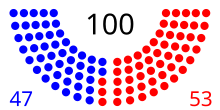
| Party (shading shows control) |
Total | Vacant | ||
|---|---|---|---|---|
|
Democratic (D) |
Republican (R) | |||
| End of previous congress | 53 | 47 | 100 | 0 |
| Begin | 47 | 53 | 100 | 0 |
| End | ||||
| Final voting share | 47.0% | 53.0% | ||
| Beginning of next congress | 45 | 55 | 100 | 0 |
House of Representatives
| Party (shading shows control) |
Total | Vacant | |||
|---|---|---|---|---|---|
|
Democratic (D) |
Independent (I) |
Republican (R) |
|||
| End of previous congress | 256 | 1 | 177 | 434 | 1 |
| Begin | 204 | 1 | 230 | 435 | 0 |
| End | 197 | 235 | 433 | 2 | |
| Final voting share | 45.5% | 0.2% | 54.3% | ||
| Non-voting members | 4 | 1 | 0 | 5 | |
| Beginning of next congress | 207 | 1 | 227 | 435 | 0 |

Leadership
Senate
- President: Al Gore (D)
- President pro tempore: Strom Thurmond (R)
Majority (Republican) leadership
-
Majority Leader:
- Bob Dole, until June 11, 1996
- Trent Lott, starting June 12, 1996
-
Majority Whip:
- Trent Lott, until June 11, 1996
- Don Nickles, starting June 12, 1996
- Republican Conference Chairman: Thad Cochran
- Republican Conference Secretary: Connie Mack III
- Republican Campaign Committee Chair: Al D'Amato
-
Republican Policy Committee Chairman:
- Don Nickles, until June 12, 1996
- Larry Craig, starting June 12, 1996
Minority (Democratic) leadership
- Minority Leader: Tom Daschle
- Minority Whip: Wendell Ford
- Policy Committee Co-Chairs: Tom Daschle and Harry Reid
- Democratic Conference Secretary: Barbara Mikulski
- Democratic Campaign Committee Chairman: Bob Kerrey
- Chief Deputy Whip: John Breaux
House of Representatives
- Speaker: Newt Gingrich (R)
Majority (Republican) leadership
- Majority Leader: Dick Armey
- Majority Vice of House: Tom DeLay
- Chief Deputy Whip: Dennis Hastert
- Republican Conference Chairman: John Boehner
- Republican Conference Vice-Chairwoman: Susan Molinari
- Republican Conference Secretary: Barbara Vucanovich
- Policy Committee Chairman: Christopher Cox
- Republican Campaign Committee Chairman: Bill Paxon
Minority (Democratic) leadership
- Minority Leader: Dick Gephardt
- Minority Whip: David Bonior
- Chief Deputy Minority Whips: Rosa DeLauro, John Lewis, & Bill Richardson
- Democratic Caucus Chairman: Vic Fazio
- Democratic Caucus Vice-Chairman: Barbara B. Kennelly
- Democratic Campaign Committee Chairman: Martin Frost
Caucuses
- Armenian Caucus
- Biomedical Research Caucus
- Blue Dog Coalition
- Congressional Arts Caucus
- Congressional Asian Pacific American Caucus
- Congressional Automotive Caucus
- Congressional Bike Caucus
- Congressional Black Caucus
- Congressional Caucus on India and Indian Americans
- Congressional Caucus on Korea
- Congressional Fire Services Caucus
- Congressional Friends of Ireland Caucus
- Congressional Hispanic Caucus
- Congressional Motorsports Caucus
- Congressional Pediatric & Adult Hydrocephalus Caucus
- Congressional Progressive Caucus
- Congressional Portuguese-American Caucus
- Congressional Travel & Tourism Caucus
- Congressional Western Caucus
- Congresswomen's Caucus
- Hong Kong Caucus
- House Democratic Caucus
- Law Enforcement Caucus
- Northern Border Caucus
- Renewable Energy and Energy Efficiency Caucus
- Senate Democratic Caucus
Members
Senate
In this Congress, Class 2 meant their term ended with this Congress, requiring re-election in 1996; Class 3 meant their term began in the last Congress, requiring re-election in 1998; and Class 1 meant their term began in this Congress, requiring re-election in 2000.
House of Representatives
The names of members of the House of Representatives are preceded by their district numbers.
Changes in membership
Senate
| State (class) |
Vacated by | Reason for change | Successor | Date of successor's formal installation [a]
|
|---|---|---|---|---|
|
Colorado (3) |
Ben Nighthorse Campbell (D) | Changed party March 3, 1995 | Ben Nighthorse Campbell (R) | March 3, 1995 |
|
Oregon (3) |
Bob Packwood (R) | Resigned September 7, 1995 after the Senate Ethics Committee recommended expulsion 6-0 over Packwood's sexual misconduct. Successor elected January 30, 1996 to the remainder of the term ending on January 3, 1999. | Ron Wyden (D) | Seated February 6, 1996 |
|
Kansas (3) |
Bob Dole (R) | Incumbent resigned on June 11, 1996, to campaign for the
Presidency. Successor was appointed the same day to continue the term. |
Sheila Frahm (R) | June 11, 1996 |
|
Kansas (3) |
Sheila Frahm (R) | Interim appointee lost nomination. Successor elected November 5, 1996 to the remainder of the term ending on January 3, 1999. |
Sam Brownback (R) | November 6, 1996 |
House of Representatives
| District | Vacated by | Reason for change | Successor | Date of successor's formal installation [a]
|
|---|---|---|---|---|
| Georgia 9th | Nathan Deal (D) | Changed party April 10, 1995 | Nathan Deal (R) | April 10, 1995 |
| Texas 14th | Greg Laughlin (D) | Changed party June 26, 1995 | Greg Laughlin (R) | June 26, 1995 |
| Louisiana 3rd | Billy Tauzin (D) | Changed party August 8, 1995 | Billy Tauzin (R) | August 8, 1995 |
| Illinois 2nd | Mel Reynolds (D) | Resigned October 1, 1995 | Jesse Jackson Jr. (D) | December 15, 1995 |
| California 15th | Norman Mineta (D) | Resigned October 10, 1995 | Tom Campbell (R) | December 12, 1995 |
| Mississippi 4th | Michael Parker (D) | Changed party November 10, 1995 | Michael Parker (R) | November 10, 1995 |
| Louisiana 7th | Jimmy Hayes (D) | Changed party December 1, 1995 | Jimmy Hayes (R) | December 1, 1995 |
| California 37th | Walter R. Tucker III (D) | Resigned December 15, 1995, due to scandals during his past tenure as Mayor of Compton | Juanita Millender-McDonald (D) | March 26, 1996 |
| Oregon 3rd | Ron Wyden (D) | Resigned February 6, 1996, after being elected to the U.S. Senate | Earl Blumenauer (D) | May 21, 1996 |
| Maryland 7th | Kweisi Mfume (D) | Resigned February 15, 1996, to become CEO of the NAACP | Elijah Cummings (D) | April 16, 1996 |
| Missouri 8th | Bill Emerson (R) | Died June 22, 1996 | Jo Ann Emerson (I/R) | November 5, 1996 |
| Kansas 2nd | Sam Brownback (R) | Resigned November 27, 1996, retroactive to November 7 after being elected to the US Senate | Jim Ryun (R) | November 27, 1996 |
| Arkansas 2nd | Ray Thornton (D) | Resigned January 1, 1997 | Vacant | Vacant for remainder of term |
| Arkansas 3rd | Tim Hutchinson (R) | Resigned January 2, 1997, after being elected to the US Senate |
Committees
Lists of committees and their party leaders for members of the House and Senate committees can be found through the Official Congressional Directory at the bottom of this article. The directory after the pages of terms of service lists committees of the Senate, House (Standing with Subcommittees, Select and Special) and Joint and, after that, House/Senate committee assignments. On the committees section of the House and Senate in the Official Congressional Directory, the committee's members on the first row on the left side shows the chairman of the committee and on the right side shows the ranking member of the committee.
Senate
- Aging (Special) ( William S. Cohen, Chair; David Pryor, Ranking Member)
-
Agriculture, Nutrition and Forestry (
Richard Lugar, Chair;
Patrick Leahy, Ranking Member)
- Forestry, Conservation and Rural Revitalization ( Larry E. Craig, Chair; Howell Heflin, Ranking Member)
- Marketing, Inspection and Product Promotion ( Jesse Helms, Chair; Kent Conrad, Ranking Member)
- Research, Nutrition and General Legislation ( Thad Cochran, Chair; David Pryor, Ranking Member)
-
Appropriations (
Mark Hatfield, Chair;
Robert C. Byrd, Ranking Member)
- Agriculture, Rural Development and Related Agencies ( Thad Cochran, Chair; Dale Bumpers, Ranking Member)
- Commerce, Justice, State and Judiciary ( Phil Gramm, Chair; Ernest Hollings, Ranking Member)
- Defense ( Ted Stevens, Chair; Daniel Inouye, Ranking Member)
- District of Columbia ( Jim Jeffords, Chair; Herb Kohl, Ranking Member)
- Energy and Water Development ( Pete Domenici, Chair; J. Bennett Johnston, Ranking Member)
- Foreign Operations ( Mitch McConnell, Chair; Patrick Leahy, Ranking Member)
- Interior and Related Agencies ( Slade Gorton, Chair; Robert C. Byrd, Ranking Member)
- Labor, Health, Human Services and Education ( Arlen Specter, Chair; Tom Harkin, Ranking Member)
- Legislative Branch ( Connie Mack III, Chair; Patty Murray, Ranking Member)
- Military Construction ( Conrad Burns, Chair; Harry Reid, Ranking Member)
- Transportation ( Mark Hatfield, Chair; Frank Lautenberg, Ranking Member)
- Treasury, Postal Service and General Government ( Richard Shelby, Chair; J. Robert Kerrey, Ranking Member)
- VA-HUD Independent Agencies ( Kit Bond, Chair; Barbara A. Mikulski, Ranking Member)
-
Armed Services (
Strom Thurmond, Chair;
Sam Nunn, Ranking Member)
- Acquisition and Technology ( Bob Smith, Chair; Jeff Bingaman, Ranking Member)
- Airland Forces ( John Warner, Chair; Carl Levin, Ranking Member)
- Personnel ( Dan Coats, Chair; Robert Byrd, Ranking Member)
- Readiness ( John McCain, Chair; John Glenn, Ranking Member)
- Seapower ( William S. Cohen, Chair; Edward M. Kennedy, Ranking Member)
- Strategic Forces ( Trent Lott, Chair; J. James Exon, Ranking Member)
-
Banking, Housing and Urban Affairs (
Al D'Amato, Chair;
Paul Sarbanes, Ranking Member)
- Securities ( Phil Gramm, Chair; Chris Dodd, Ranking Member)
- Financial Institutions and Regulatory Relief ( Richard Shelby, Chair; Richard Bryan, Ranking Member)
- International Finance ( Kit Bond, Chair; Barbara Boxer, Ranking Member)
- Housing Opportunity and Community Development ( Connie Mack III, Chair; John F. Kerry, Ranking Member)
- HUD Oversight and Activities ( Lauch Faircloth, Chair; Carol Moseley-Braun, Ranking Member)
- Budget ( Pete Domenici, Chair; J. James Exon, Ranking Member)
-
Commerce, Science and Transportation (
Larry Pressler, Chair;
Ernest F. Hollings, Ranking Member)
- Aviation ( John McCain, Chair; Wendell H. Ford, Ranking Member)
- Communications ( Bob Packwood, Chair; Ernest F. Hollings, Ranking Member)
- Consumer Affairs, Foreign Commerce and Tourism ( Slade Gorton, Chair; J. James Exon, Ranking Member)
- Oceans and Fisheries ( Ted Stevens, Chair; John F. Kerry, Ranking Member)
- Science, Technology and Space ( Conrad Burns, Chair; John D. Rockefeller IV, Ranking Member)
- Surface Transportation and Merchant Marine ( Trent Lott, Chair; Daniel K. Inouye, Ranking Member)
-
Energy and Natural Resources (
Frank H. Murkowski, Chair;
J. Bennett Johnston, Ranking Member)
- Energy Production and Regulation ( Don Nickles, Chair; Jeff Bingaman, Ranking Member)
- Energy Research and Development ( Pete Domenici, Chair; Wendell H. Ford, Ranking Member)
- Forests and Public Land Management ( Larry E. Craig, Chair; Bill Bradley, Ranking Member)
- Parks, Historic Preservation and Recreation ( Ben Nighthorse Campbell, Chair; Dale Bumpers, Ranking Member)
- Oversight and Investigations ( Craig Thomas, Chair; Daniel Akaka, Ranking Member)
-
Environment and Public Works (
John H. Chafee, Chair;
Max Baucus, Ranking Member)
- Clear Air, Wetlands, Private Property and Nuclear Safety ( Lauch Faircloth, Chair; Bob Graham, Ranking Member)
- Drinking Water, Fisheries and Wildlife ( Dirk Kempthorne, Chair; Harry Reid, Ranking Member)
- Superfund, Waste Control and Risk Assessment ( Bob Smith, Chair; Frank Lautenberg, Ranking Member)
- Transportation and Infrastructure ( John Warner, Chair; Max Baucus, Ranking Member)
- Ethics (Select) ( Mitch McConnell, Chair; Richard H. Bryan, Ranking Member)
-
Finance (
Bob Packwood, Chair;
Daniel Patrick Moynihan, Ranking Member)
- International Trade ( Chuck Grassley, Chair; Daniel Patrick Moynihan, Ranking Member)
- Long-Term Growth, Debt and Deficit Reduction ( Larry Pressler, Chair; David H. Pryor, Ranking Member)
- Medicare, Long-Term Care and Health Insurance ( John H. Chafee, Chair; Bob Graham, Ranking Member)
- Medicaid and Health-Care for Low-Income Families ( Bob Dole, Chair; John D. Rockefeller IV, Ranking Member)
- Social Security and Family Policy ( Alan K. Simpson, Chair; John B. Breaux, Ranking Member)
- Taxation and IRS Oversight ( Orrin G. Hatch, Chair; Bill Bradley, Ranking Member)
-
Foreign Relations (
Jesse Helms, Chair;
Claiborne Pell, Ranking Member)
- African Affairs ( Nancy Kassebaum, Chair; Russ Feingold, Ranking Member)
- East Asian and Pacific Affairs ( Craig Thomas, Chair; Charles Robb, Ranking Member)
- European Affairs ( Richard Lugar, Chair; Joe Biden, Ranking Member)
- International Economic Policy, Export and Trade Promotion ( Fred Thompson, Chair; Paul S. Sarbanes, Ranking Member)
- International Operations ( Olympia J. Snowe, Chair; John Kerry, Ranking Member)
- Near Eastern and South Asian Affairs ( Hank Brown, Chair; Dianne Feinstein, Ranking Member)
- Western Hemisphere and Peace Corps Affairs ( Paul Coverdell, Chair; Chris Dodd, Ranking Member)
-
Governmental Affairs (
Bill Roth, Chair;
John Glenn, Ranking Member)
- Oversight of Government Management and the District of Columbia ( William S. Cohen, Chair; Carl Levin, Ranking Member)
- Permanent Subcommittee on Investigations ( Bill Roth, Chair; Sam Nunn, Ranking Member)
- International Economic Policy, Export and Trade Promotion ( Fred Thompson, Chair; Paul Sarbanes, Ranking Member)
- Post Office and Civil Service ( Ted Stevens, Chair; David Pryor, Ranking Member)
- Indian Affairs (Select) ( John McCain, Chair; Daniel K. Inouye, Ranking Member)
-
Judiciary (
Orrin G. Hatch, Chair;
Joe Biden, Ranking Member)
- Administration Oversight and the Courts ( Chuck Grassley, Chair; Howell Heflin, Ranking Member)
- Antitrust, Business Rights and Competition ( Strom Thurmond, Chair; Patrick Leahy, Ranking Member)
- Constitution, Federalism and Property Rights ( Hank Brown, Chair; Paul Simon, Ranking Member)
- Immigration ( Alan K. Simpson, Chair; Edward M. Kennedy, Ranking Member)
- Terrorism, Technology and Government Information ( Arlen Specter, Chair; Herb Kohl, Ranking Member)
- Youth Violence ( Fred Thompson, Chair; Joe Biden, Ranking Member)
- Intelligence (Select) ( Arlen Specter, Chair; J. Robert Kerrey, Vice Chair)
-
Labor and Human Resources (
Nancy Landon Kassebaum, Chair;
Edward M. Kennedy, Ranking Member)
- Aging ( Judd Gregg, Chair; Barbara A. Mikulski, Ranking Member)
- Children and Families ( Dan Coats, Chair; Chris Dodd, Ranking Member)
- Disability Policy ( Bill Frist, Chair; Tom Harkin, Ranking Member)
- Education, Arts and Humanities ( Jim Jeffords, Chair; Claiborne Pell, Ranking Member)
- Rules and Administration ( Ted Stevens, Chair; Wendell H. Ford, Ranking Member)
- Small Business ( Kit Bond, Chair; Dale Bumpers, Ranking Member)
- Veterans' Affairs ( Alan K. Simpson, Chair; John D. Rockefeller IV, Ranking Member)
- Whitewater Committee (Special) ( Al D'Amato, Chair; Paul Sarbanes, Ranking Member)
House of Representatives
-
Agriculture (
Pat Roberts, Chair;
Kika de la Garza, Ranking Member)
- General Farm Commodities ( Bill Barrett, Chair; Charles W. Stenholm, Ranking Member)
- Livestock, Dairy and Poultry ( Steve Gunderson, Chair; Harold Volkmer, Ranking Member)
- Risk Management and Specialty Crops ( Thomas W. Ewing, Chair; Charlie Rose, Ranking Member)
- Department Operations, Nutrition and Foreign Agriculture ( Bill Emerson, Chair; Gary A. Condit, Ranking Member)
- Resource Conservation, Research and Forestry ( Wayne Allard, Chair; Tim Johnson, Ranking Member)
-
Appropriations (
Bob Livingston, Chair;
Dave Obey, Ranking Member)
- Agriculture, Rural Development, Food and Drug Administration and Related Agencies ( Joe Skeen, Chair; Dick Durbin, Ranking Member)
- Commerce, Justice, State and Judiciary ( Hal Rogers, Chair; Alan B. Mollohan, Ranking Member)
- District of Columbia ( James T. Walsh, Chair; Julian Dixon, Ranking Member)
- Energy and Water Development ( John T. Myers, Chair; Tom Bevill, Ranking Member)
- Foreign Operations, Export Financing and Related Programs ( Sonny Callahan, Chair; Charlie Wilson, Ranking Member)
- Labor, Health, Human Services and Education ( John Edward Porter, Chair; David Obey, Ranking Member)
- Interior ( Ralph Regula, Chair; Sidney Yates, Ranking Member)
- Legislative ( Ron Packard, Chair; Vic Fazio, Ranking Member)
- Military Construction ( Barbara Vucanovich, Chair; Bill Hefner, Ranking Member)
- National Security ( Bill Young, Chair; John Murtha, Ranking Member)
- Transportation ( Frank Wolf, Chair; Martin Olav Sabo, Ranking Member)
- Treasury, Postal Service and General Government ( Jim Lightfoot, Chair; Steny Hoyer, Ranking Member)
- VA, HUD and Independent Agencies ( Jerry Lewis, Chair; Louis Stokes, Ranking Member)
-
Banking and Financial Services (
Jim Leach, Chair;
Henry B. Gonzalez, Ranking Member)
- Capital Markets, Securities and Government-Sponsored Enterprises ( Richard H. Baker, Chair; Paul E. Kanjorski, Ranking Member)
- Domestic and International Monetary Policy ( Michael Castle, Chair; Floyd Flake, Ranking Member)
- Financial Institutions and Consumer Credit ( Marge Roukema, Chair; Bruce Vento, Ranking Member)
- General Oversight and Investigations ( Spencer Bachus, Chair; Kweisi Mfume, Ranking Member)
- Housing and Community Opportunity ( Rick Lazio, Chair; Joseph P. Kennedy II, Ranking Member)
- Budget ( John Kasich, Chair; Martin Olav Sabo, Ranking Member)
-
Commerce (
Thomas J. Bliley, Chair;
John D. Dingell, Ranking Member)
- Commerce, Trade and Hazardous Materials ( Mike Oxley, Chair; Billy Tauzin, Ranking Member)
- Energy and Power ( Dan Schaefer, Chair; Frank Pallone, Ranking Member)
- Health and Environment ( Michael Bilirakis, Chair; Henry A. Waxman, Ranking Member)
- Oversight and Investigations ( Joe Barton, Chair; Ron Wyden, Ranking Member)
- Telecommunications and Finance ( Jack Fields, Chair; Edward J. Markey, Ranking Member)
-
Economic and Educational Opportunities (
Bill Goodling, Chair;
Bill Clay, Ranking Member)
- Early Childhood, Youth and Families ( Duke Cunningham, Chair; Dale E. Kildee, Ranking Member)
- Employer-Employee Relations ( Harris W. Fawell, Chair; Matthew G. Martinez, Ranking Member)
- Oversight and Investigations ( Peter Hoekstra, Chair; Thomas C. Sawyer, Ranking Member)
- Postsecondary Education, Training and Life-Long Learning ( Buck McKeon, Chair; Pat Williams, Ranking Member)
- Workforce Protections ( Cass Ballenger, Chair; Major Owens, Ranking Member)
-
Government Reform and Oversight (
William F. Clinger, Chair;
Cardiss Collins, Ranking Member)
- Civil Service ( John Mica, Chair; Jim Moran, Ranking Member)
- District of Columbia ( Thomas M. Davis, Chair; Eleanor Holmes Norton, Ranking Member)
- Government Management, Information and Technology ( Steve Horn, Chair; Carolyn B. Maloney, Ranking Member)
- Human Resources and Ingovernmental Relations ( Chris Shays, Chair; Edolphus Towns, Ranking Member)
- National Economic Growth, Natural Resources and Regulatory Affairs ( David McIntosh, Chair; Collin C. Peterson, Ranking Member)
- National Security, International Affairs and Criminal Justice ( Bill Zeliff, Chair; Karen L. Thurman, Ranking Member)
- Postal Service ( John M. McHugh, Chair; Barbara-Rose Collins, Ranking Member)
- House Administration ( Bill Thomas, Chair; Vic Fazio, Ranking Member)
-
International Relations (
Benjamin Gilman, Chair;
Lee H. Hamilton, Ranking Member)
- International Economic Policy and Trade ( Toby Roth, Chair; Sam Gejdenson, Ranking Member)
- Asia and the Pacific ( Doug Bereuter, Chair; Howard Berman, Ranking Member)
- International Operations and Human Rights ( Christopher H. Smith, Chair; Tom Lantos, Ranking Member)
- Western Hemisphere ( Dan Burton, Chair; Robert G. Torricelli, Ranking Member)
- Africa ( Ileana Ros-Lehtinen, Chair; Gary L. Ackerman, Ranking Member)
-
Judiciary (
Henry J. Hyde, Chair;
John Conyers, Ranking Member)
- Commercial and Administrative Law ( George W. Gekas, Chair; Jack Reed, Ranking Member)
- Courts and Intellectual Property ( Carlos J. Moorhead, Chair; Patricia Schroeder, Ranking Member)
- Crime ( Bill McCollum, Chair; Chuck Schumer, Ranking Member)
- Immigration and Claims ( Lamar S. Smith, Chair; John Bryant, Ranking Member)
- The Constitution ( Charles T. Canady, Chair; Barney Frank, Ranking Member)
-
National Security (
Floyd D. Spence, Chair;
Ron Dellums, Ranking Member)
- Military Installations and Facilities ( Joel Hefley, Chair; Solomon P. Ortiz, Ranking Member)
- Military Personnel ( Bob Dornan, Chair; Owen B. Pickett, Ranking Member)
- Military Procurement ( Duncan Hunter, Chair; Ike Skelton, Ranking Member)
- Military Readiness ( Herbert H. Bateman, Chair; Norman Sisisky, Ranking Member)
- Military Research and Development ( Curt Weldon, Chair; John M. Spratt, Ranking Member)
-
Resources (
Don Young, Chair;
George Miller, Ranking Member)
- Energy and Mineral Resources ( Ken Calvert, Chair; Neil Abercrombie, Ranking Member)
- Fisheries, Wildlife and Oceans ( Jim Saxton, Chair; Gerry E. Studds, Ranking Member)
- National Parks, Forests and Lands ( James V. Hansen, Chair; Bill Richardson, Ranking Member)
- Native American and Insular Affairs ( Elton Gallegly, Chair; Eni Faleomavaega, Ranking Member)
- Water and Power Resources ( John T. Doolittle, Chair; Peter A. DeFazio, Ranking Member)
-
Rules (
Gerald B.H. Solomon, Chair;
Joe Moakley, Ranking Member)
- Legislative Process ( Porter Goss, Chair; Martin Frost, Ranking Member)
- Rules of the House ( David Dreier, Chair; Anthony C. Beilenson, Ranking Member)
-
Science (
Robert S. Walker, Chair;
George E. Brown Jr., Ranking Member)
- Basic Research ( Steven Schiff, Chair; Pete Geren, Ranking Member)
- Energy and Development ( Dana Rohrabacher, Chair; James A. Hayes, Ranking Member)
- Space and Aeronautics ( Jim Sensenbrenner, Chair; Ralph M. Hall, Ranking Member)
- Technology ( Constance A. Morella, Chair; John S. Tanner, Ranking Member)
-
Small Business (
Jan Meyers, Chair;
John L. LaFalce, Ranking Member)
- Government Programs ( Peter G. Torkildsen, Chair; Glenn Poshard, Ranking Member)
- Procurement, Exports and Business Opportunities ( Donald A. Manzullo, Chair; Eva Clayton, Ranking Member)
- Regulation and Paperwork ( Jim Talent, Chair; Nydia Velazquez, Ranking Member)
- Tax and Finance ( Linda Smith, Chair; Marty Meehan, Ranking Member)
- Standards of Official Conduct ( Nancy Johnson, Chair; Jim McDermott, Ranking Member)
-
Transportation and Infrastructure (
Bud Shuster, Chair;
Norman Mineta, Ranking Member)
- Aviation ( John J. Duncan Jr., Chair; James L. Oberstar, Ranking Member)
- Coast Guard and Maritime Transportation ( Howard Coble, Chair; James A. Traficant, Ranking Member)
- Public Buildings and Economic Development ( Wayne T. Gilchrest, Chair; Robert E. Wise Jr., Ranking Member)
- Railroads ( Susan Molinari, Chair; William O. Lipinski, Ranking Member)
- Surface Transportation ( Tom Petri, Chair; Nick J. Rahall, Ranking Member)
- Water Resources and Development ( Sherwood Boehlert, Chair; Robert A. Borski, Ranking Member)
-
Veterans' Affairs (
Bob Stump, Chair;
Sonny Montgomery, Ranking Member)
- Compensation, Pension, Insurance and Memorial Affairs ( Terry Everett, Chair; Lane Evans, Ranking Member)
- Education, Training, Employment and Housing ( Steve Buyer, Chair; Maxine Waters, Ranking Member)
- Hospitals and Health Care ( Tim Hutchinson, Chair; Chet Edwards, Ranking Member)
-
Ways and Means (
Bill Archer, Chair;
Sam Gibbons, Ranking Member)
- Health ( Bill Thomas, Chair; Charles Rangel, Ranking Member)
- Human Resources ( E. Clay Shaw Jr., Chair; Harold E. Ford Sr., Ranking Member)
- Oversight ( Nancy Johnson, Chair; Bob Matsui, Ranking Member)
- Social Security ( Jim Bunning, Chair; Andrew Jacobs Jr., Ranking Member)
- Trade ( Phil Crane, Chair; Charles Rangel, Ranking Member)
- Whole
Joint committees
- Economic (Sen. Connie Mack, Chair; Rep. Jim Saxton, Vice Chair)
- Taxation (Rep. Bill Archer, Chair; Sen. Bob Packwood, Vice Chair)
- The Library (Sen. Mark Hatfield, Chair; Rep. Bill Thomas, Vice Chair)
- Printing (Rep. Bill Thomas, Chair; Sen. Ted Stevens, Vice Chair)
Employees
Legislative branch agency directors
-
Architect of the Capitol:
- George M. White, until November 21, 1995
- William L. Ensign (acting), from November 21, 1995
- Attending Physician of the United States Congress: John F. Eisold
-
Comptroller General of the United States:
- Charles A. Bowsher, until 1996
- vacant, starting 1996
- Director of the
Congressional Budget Office:
- Robert D. Reischauer, until February 28, 1995
- June E. O'Neill, from March 1, 1995
- Librarian of Congress: James H. Billington
- Public Printer of the United States: Michael F. DiMario
Senate
-
Chaplain:
- Richard C. Halverson ( Presbyterian), until March 11, 1995
- Lloyd John Ogilvie ( Presbyterian), from March 11, 1995
-
Curator:
- James R. Ketchum, until July 1, 1995
- Diane K. Skvarla, from July 1, 1995
- Historian: Richard A. Baker
- Parliamentarian: Bob Dove
-
Secretary:
- Sheila P. Burke, until June 7, 1995
- Kelly D. Johnston, June 8, 1995 – September 30, 1996
- Gary Lee Sisco, from October 1, 1996
- Librarian: Roger K. Haley
- Secretary for the Majority: Elizabeth B. Greene
-
Secretary for the Minority:
- C. Abbott Saffold, until 1995
- Martin P. Paone, from 1995
-
Sergeant at Arms:
- Howard O. Greene Jr., until September 6, 1996
- Gregory S. Casey, from September 6, 1996
House of Representatives
- Chaplain: James D. Ford ( Lutheran)
-
Chief Administrative Officer:
- Scott Faulkner, until November 22, 1996
- Jeff Trandahl (acting), from November 22, 1996
- Clerk: Robin H. Carle
- Historian: Christina Jeffrey, 1995 (briefly) [1]
- Parliamentarian: Charles W. Johnson III
- Reading Clerks:
- Sergeant at Arms: Wilson Livingood
- Inspector General: John W. Lainhart IV
See also
- List of new members of the 104th United States Congress
- 1994 United States elections (elections leading to this Congress)
- 1996 United States elections (elections during this Congress, leading to the next Congress)
Notes
References
- ^ "Historian Newt Gingrich Responsible For Decade Long Lack Of Official House Historian". wordpress.com. January 25, 2012. Retrieved April 6, 2018.
External links
- Biographical Directory of the U.S. Congress
- U.S. House of Representatives: Congressional History
- U.S. Senate: Statistics and Lists
- "Videos of House of Representatives Sessions for the 104th Congress from www.C-SPAN.org".
- "Videos of Senate Sessions for the 104th Congress from www.C-SPAN.org".
- "Videos of Committees from the House and Senate for the 104th Congress from www.C-SPAN.org".
- House of Representatives Session Calendar for the 104th Congress (PDF). Archived from the original (PDF) on July 6, 2016. Retrieved June 6, 2016.
- Congressional Pictorial Directory for the 104th Congress.
- Congressional Pictorial Directory for the 104th Congress (Revised).
- Official Congressional Directory for the 104th Congress. hdl: 2027/uc1.31210012145981.
